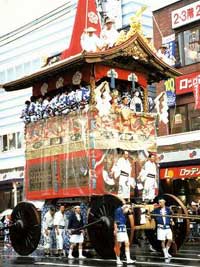July:Kyoto Gion Festival(日本京都祗园祭)
(单词翻译:单击)
|
This Japanese festival begins July 1st and lasts until July 31st. At this time, there are many street vendors2 with games and Japanese festival food. Also, many people who go to this festival wear yukata (浴衣) and geta (木屐), which are traditional Japanese outfits3. It is said that the summer of Kyoto begins with the Gion Matsuri (祗园祭). It is a traditional summer festivity. Gion festival was started in 869 A.D when a bad plague (瘟疫) spread through Kyoto. In the first festival, young men carried numbers of wooden floats. It was a divine intervention4 to stop the plague. The plague soon ended, and this event became a popular festival. In the Edo Era (江户时代), the current form of the decorated floats appeared in the festival. There are many events held during this festival, but the highlights are Yoi-yama (宵山祭) on the 16th and Yamahoko-junko (山牟巡行) on the 17th. At Yoi-yama, people open the doors of their houses to show their treasured old folding screens. Yamahoko-junko is the parade of colorful floats (彩车) through downtown Kyoto. The floats are pulled through the streets by teams of men dressed in traditional costumes. Each of the large floats carries musicians. There are two kinds of floats: yama (山) and hook (牟). Yama are smaller floats (weight: 1.2 ton - 1.6 ton, height: about 6m) and carried by people on their shoulders. Hoko are giant floats (weight: 4.8 ton - 12 ton, height: about 25m) on large wooden wheels and pulled by people. There are 32 floats in the parade: 25 yama floats and 7 hoko floats. The floats are decorated with tapestries5 or fabrics6 from Nishijin (西阵), Kyoto. Many of them were imported from India, Belgium, Persia, Turkey and other countries in the 15th century. |
 收听单词发音
收听单词发音
1
shrine

|
|
| n.圣地,神龛,庙;v.将...置于神龛内,把...奉为神圣 | |
参考例句: |
|
|
|
2
vendors

|
|
| n.摊贩( vendor的名词复数 );小贩;(房屋等的)卖主;卖方 | |
参考例句: |
|
|
|
3
outfits

|
|
| n.全套装备( outfit的名词复数 );一套服装;集体;组织v.装备,配置设备,供给服装( outfit的第三人称单数 ) | |
参考例句: |
|
|
|
4
intervention

|
|
| n.介入,干涉,干预 | |
参考例句: |
|
|
|
5
tapestries

|
|
| n.挂毯( tapestry的名词复数 );绣帷,织锦v.用挂毯(或绣帷)装饰( tapestry的第三人称单数 ) | |
参考例句: |
|
|
|
6
fabrics

|
|
| 织物( fabric的名词复数 ); 布; 构造; (建筑物的)结构(如墙、地面、屋顶):质地 | |
参考例句: |
|
|
|

 The ancient capital of Japan, Kyoto (京都) is taken back in time during the Gion festival (祗园祭) by Yasaka
The ancient capital of Japan, Kyoto (京都) is taken back in time during the Gion festival (祗园祭) by Yasaka 


